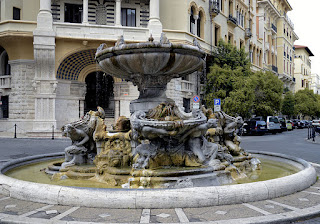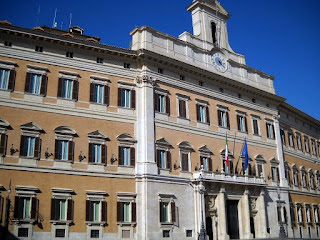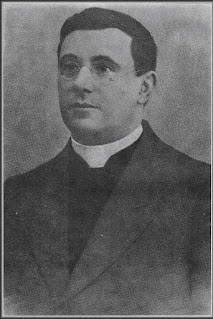Communist who eventually allied with Mussolini
Nicola Bombacci, who was executed with Fascist leader Benito Mussolini after partisans intercepted their attempt to flee Italy in 1945, was born on this day in 1879 in Civitella di Romagna, a small town about 40 minutes by road from the city of Forlì in Emilia-Romagna. .jpg)
Nicola Bombacci led the
Italian Communist Party
Although he ended his life as a political ally of the right-wing dictator, Bombacci’s roots were in Marxism. Indeed, he had been a founder-member in 1921 of the Italian Communist Party, alongside among others Antonio Gramsci, the left-wing intellectual who was subsequently arrested by Mussolini and sentenced to 20 years in jail.
He shifted his position during the 1930s, seeing fascism as a form of national socialism that could unify Italy. He embraced Mussolini's Italian Social Republic, the German puppet state in northern Italy created after the Nazis had freed the deposed dictator from house arrest in 1943, believing it to represent a blend of Marxist principles and fascist ideology that could still be a force for good.
Born little more than 20km (12 miles) from Mussolini’s home town of Predappio, Bombacci’s connections with the future dictator can be traced back to his early 20s, when they attended the same teacher training college in Forlimpopoli.
Both became members of the Italian Socialist Party (PSI), their political beliefs so closely aligned that both were part of the revolutionary Massimalisti wing on the far left of the party.
 |
| Benito Mussolini shared Bombacci's enthusiasm for left-wing politics |
In 1919 - the same year that Bombacci became Secretary of the PSI - Mussolini was hosting a rally in Milan that saw the establishment of the Fasci Italiani di Combattimento (Italian Combat Group), which would evolve into the National Fascist Party two years later.
Bombacci led the PSI with notable success, winning 32.3 per cent of the vote in the 1919 general election, which made them the biggest party by votes and seats.
However, he resigned his position only a year later, feeling his authority had been compromised when his proposed constitution of the Soviets in Italy was rejected. In the summer of 1920 he was among an Italian delegation that went to Soviet Russia, participating in the Second Congress of the Communist International, and in 1921 opted to join Gramsci and fellow Marxist Amadeo Bordiga in founding the Communist Party of Italy (PCd'I).
As support for Mussolini grew, opponents such as the Socialists and Communists increasingly became the target of violent attacks by Blackshirt thugs, no less so after his Fascist Party were handed power in 1922 following the March on Rome.
Gramsci’s arrest in 1926 followed two years after the murder of Giacomo Matteotti, 29-year-old founder and leader of the Unified Socialist Party, who had delivered a speech in parliament accusing Mussolini of winning the 1924 general election by fraud and intimidation.
.png) |
| Antonio Gramsci, Bombacci's fellow communist, was arrested and jailed |
Expelled from the PCI in 1927 for taking a pro-fascist position, Bombacci responded by becoming openly fascist, although he never officially joined the National Fascist Party. By the beginning of the 1940s, Bombacci’s position had shifted to the degree that he began publishing pamphlets warning the Italian population on the dangers of Bolshevism and attacking Stalin for betraying socialist values.
Mussolini in turn helped Bombacci by providing financial support for the care of his sick son, Wladimiro, and allowing him to found and edit a new magazine, La Verità, sponsored by the Ministry of Culture, promoting views aligned to those of the regime.
Their relationship became stronger still after Mussolini, freed from captivity by Nazi paratroopers after being arrested on the orders of King Victor Emmanuel III 1943, was installed as leader of the Italian Social Republic, a puppet state established on territory controlled by the Germans in northern and central Italy.
Bombacci voluntarily travelled to the republic’s headquarters in Salò, on the shores of Lake Garda, where he became an advisor to Mussolini. He was the author of the economic theory of fascist socialisation, designed to put more power in the hands of workers through the state control of businesses and the means of production.
 |
| The bodies of Bombacci (first left) and the others in Piazzale Loreto |
It was not long, however, before the Allied advance from the south steadily forced the German army into retreat. Sensing that it was only a matter of time before the Italian Social Republic collapsed, Mussolini hatched a plan to escape to Switzerland.
Along with Mussolini’s mistress, Claretta Petacci, Bombacci and other loyalists, including Achille Starace and Alessandro Pavolini, accompanied the former Duce in a car hoping to reach the Swiss border. They had been on the run for only a day, however, when Mussolini was recognised at a checkpoint set up by Italian partisans at Dongo on the shores of Lake Como and captured.
Two days later, Mussolini and the others were executed. Their bodies were taken to Milan and hung by their feet from a beam above a petrol station in Piazzale Loreto, symbolically chosen as it had been the scene of a massacre of Milanese citizens by Fascist militia a year earlier.
Travel tip:A view from Piazza Principale
in Civitella di Romagna
Nicola Bombacci was born in Civitella di Romagna, a charming small town in the province of Forlì-Cesena, about 30km (19 miles) southwest of Forlì and 40km (25 miles) southwest of Cesena. It is bisected by the Bidente river in an area of picturesque green hills. It has a well-preserved mediaeval centre with bastion walls as well as an ancient castle. Civitella di Romagna is known for its annual cherry jam festival and hosts numerous markets throughout the year. The Santuario della Beata Vergine della Suasia, situated at the western end of the town, is a significant religious site dating back to the 18th century.
Travel tip:
The waterfront at Salò, these days a pleasant and
popular resort among visitors to Lake Garda
For all its regrettable association with such a despised figure as Mussolini, Salò has recovered to become a pleasant resort on the shore of Lake Garda, visited by many tourists each year. Its promenade, the Lungolago Zanardelli, is the longest of any of the lakeside towns and it has a Duomo, the Cattedrale di Santa Maria Annunziata, that was rebuilt in Gothic style in the 15th century. The Museo di Salò commemorates, among other things, the resistance against Fascism. During his time as leader of the Italian Social Republic, Mussolini lived about 18km (11 miles) to the north of Salò in the Villa Feltrinelli at Gargnano, a sumptuous lakeside palazzo which he confiscated from the Feltrinelli family, who had built it at the end of the 19th century as a summer residence.
Also on this day:
51: The birth of Roman emperor Domitian
1784: The birth of philanthropist and businessman Sir Moses Montefiore
1913: The birth of baritone Tito Gobbi
1925: The birth of composer Luciano Berio



.jpg)















_(cropped).jpg)





.jpg)
.jpg)

.JPG)




